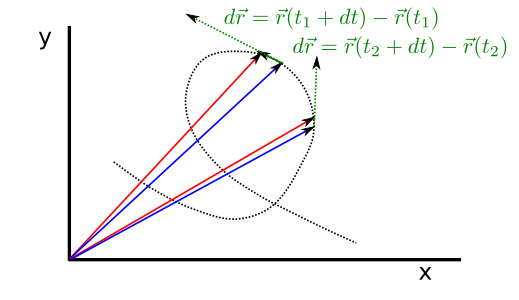Vector derivative¶
Given a vector there are many possible definitions for its derivative. In physics we are going to assume that the vector depends on a parameter (that, in practice, will be time) and what we want to find is how the vector changes with that parameter.
Definition¶
Its change is,
Practical tip
To derive a vector the most simple thing to do is letting usual derivative rules for functions guide you. That is, when we have a vector function expressed as a linear combination of coefficients times a particular vector basis you just need to use the normal derivative rules for addition and product of functions in the following way:
Properties¶
One of the most important properties of the derivative of a vector is that the result is a vector that is always tangential to the curve drawn by the vector when the parameter used in the derivative is changed.

Fig. 16 The derivative of a vector is tangent to the curve drawn by the function when the parameter is changed.¶
For the formal demonstration we will remember that the geometric interpretation of the derivative of a function: the derivative represents the slope of a tangent line to the function in which it is evaluated. Thus, observing the expression of the derivative of a vector in a cartesian basis:
we can assert that the derivative \(df_i/dt\) is tangent to the curve created by \(\vec{f}\) in the \(\vec{u}_i\) direction.
